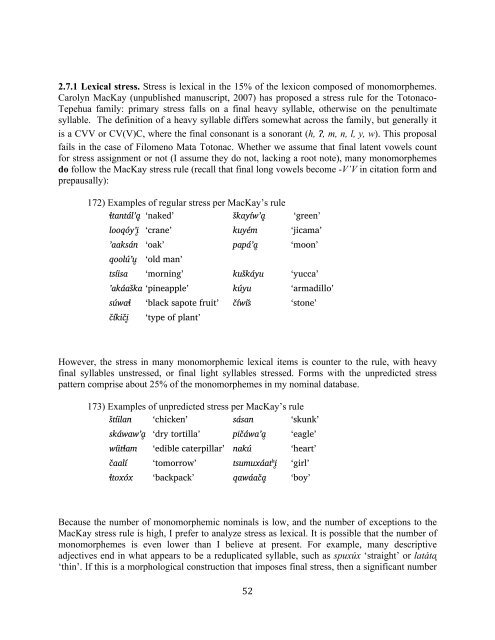The phonology and morphology of Filomeno Mata Totonac
The phonology and morphology of Filomeno Mata Totonac
The phonology and morphology of Filomeno Mata Totonac
You also want an ePaper? Increase the reach of your titles
YUMPU automatically turns print PDFs into web optimized ePapers that Google loves.
2.7.1 Lexical stress. Stress is lexical in the 15% <strong>of</strong> the lexicon composed <strong>of</strong> monomorphemes.<br />
Carolyn MacKay (unpublished manuscript, 2007) has proposed a stress rule for the <strong>Totonac</strong>o-<br />
Tepehua family: primary stress falls on a final heavy syllable, otherwise on the penultimate<br />
syllable. <strong>The</strong> definition <strong>of</strong> a heavy syllable differs somewhat across the family, but generally it<br />
is a CVV or CV(V)C, where the final consonant is a sonorant (h, $, m, n, l, y, w). This proposal<br />
fails in the case <strong>of</strong> <strong>Filomeno</strong> <strong>Mata</strong> <strong>Totonac</strong>. Whether we assume that final latent vowels count<br />
for stress assignment or not (I assume they do not, lacking a root note), many monomorphemes<br />
do follow the MacKay stress rule (recall that final long vowels become -V’V in citation form <strong>and</strong><br />
prepausally):<br />
172) Examples <strong>of</strong> regular stress per MacKay’s rule<br />
"tantál’a& ‘naked’ s%kayíw’a& ‘green’<br />
looqóy’i& ‘crane’ kuyém ‘jicama’<br />
’aaksán ‘oak’ papá’a& ‘moon’<br />
qoolú’u& ‘old man’<br />
tsíisa ‘morning’ kus%káyu ‘yucca’<br />
’akáas%ka ‘pineapple’ kúyu ‘armadillo’<br />
súwa" ‘black sapote fruit’ c%íwis" ‘stone’<br />
c%íkic%i& ‘type <strong>of</strong> plant’<br />
However, the stress in many monomorphemic lexical items is counter to the rule, with heavy<br />
final syllables unstressed, or final light syllables stressed. Forms with the unpredicted stress<br />
pattern comprise about 25% <strong>of</strong> the monomorphemes in my nominal database.<br />
173) Examples <strong>of</strong> unpredicted stress per MacKay’s rule<br />
s%tíilan ‘chicken’ sásan ‘skunk’<br />
skáwaw’a& ‘dry tortilla’ pic%áwa’a& ‘eagle’<br />
wíit"am ‘edible caterpillar’ nakú ‘heart’<br />
c%aalí ‘tomorrow’ tsumuxáat h i& ‘girl’<br />
"toxóx ‘backpack’ qawáac%a& ‘boy’<br />
Because the number <strong>of</strong> monomorphemic nominals is low, <strong>and</strong> the number <strong>of</strong> exceptions to the<br />
MacKay stress rule is high, I prefer to analyze stress as lexical. It is possible that the number <strong>of</strong><br />
monomorphemes is even lower than I believe at present. For example, many descriptive<br />
adjectives end in what appears to be a reduplicated syllable, such as spuxúx ‘straight’ or latáta"<br />
‘thin’. If this is a morphological construction that imposes final stress, then a significant number<br />
! )#!

















